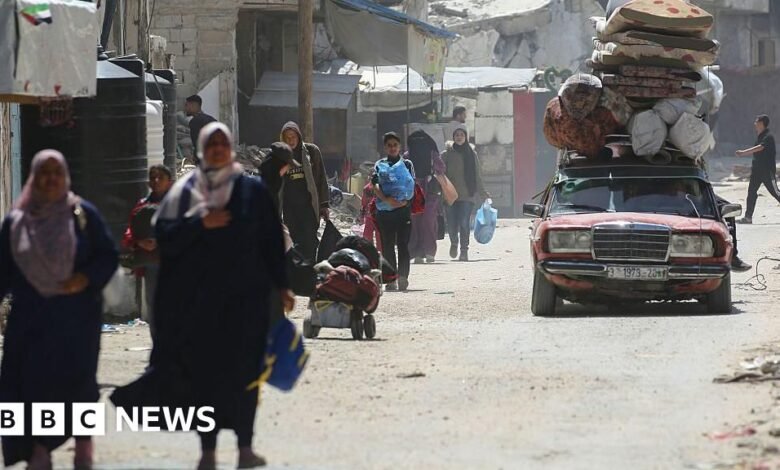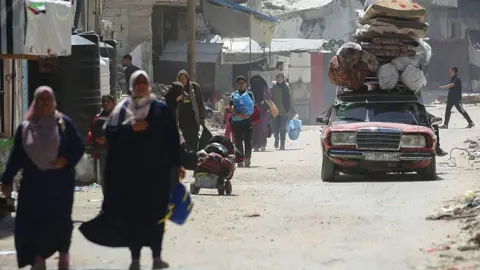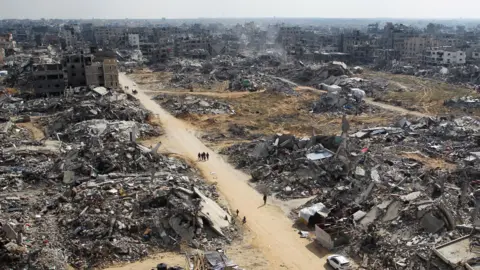Israel will expand Gaza ‘security zones’ to include Rafah

 AFP
AFPIsrael’s defence minister has said it will expand its so-called “security zones” in Gaza to include the southern city of Rafah.
During a visit to the area, Israel Katz said the military was leaving Gaza “smaller” and “more isolated” to pressure Hamas into releasing the hostages it is still holding.
The military has already seized land running along the entirety of the Palestinian territory’s borders, which it has characterised as a buffer zone to prevent attacks.
The expansion to cover Rafah and its surrounding areas – which make up almost one fifth of Gaza – comes after the military ordered civilians to evacuate and established a new corridor separating them from nearby Khan Younis.
Two-thirds of Gaza has been designated as “no-go” zones or placed under evacuation orders since Israel resumed its offensive against Hamas on 18 March following the collapse of a two-month ceasefire, according to the UN.
It says 390,000 Palestinians – almost a fifth of the 2.1 million population – have been displaced once again, with no safe place to go.
The UN is also warning that supplies of food, medicine and fuel have run out because Israel blocked deliveries of humanitarian aid to Gaza since 2 March.
The Israel Defense Forces (IDF) launched a ground offensive in Rafah – home to about 280,000 people before the war – last May, leaving large parts of the city in ruins.
It also seized a strategically important strip of land running along the nearby border with Egypt, known as the “Philadelphi Corridor”, which it said was necessary to prevent weapons being smuggled into Gaza and Hamas rearming.
During the ceasefire that began in January, about 100,000 residents returned to what was left of their homes in the city after troops pulled back to border areas.
On 31 March, almost two weeks after the resumption of the war, the IDF issued a new sweeping evacuation order that the UN said covered 97% of Rafah and its surrounding governorate, spanning 64 sq km (25 sq miles).
Displaced people were told to head to tent camps in the coastal al-Mawasi area, which the IDF previously designated as a “humanitarian zone”.
The Rafah area was reported to be almost completely empty when Israeli Prime Minister Benjamin Netanyahu announced three days later that troops were “seizing the Morag Corridor” – a reference to a former Jewish settlement located between Rafah and Khan Younis.
He said it would be “the second Philadelphi” and would increase pressure on Hamas to hand over the remaining 59 hostages, 24 of whom are believed to be alive.
On Wednesday, Defence Minister Israel Katz visited troops deployed in the new corridor with senior Israeli commanders and journalists.
“The IDF is eliminating terrorists, locating and thwarting terrorist infrastructure, and dismembering the Gaza Strip, even in places like the Morag corridor, where we have not operated to date,” he said in a video later released by his office.
“The population of Gaza is being evacuated from the fighting zones, and many areas are being seized and added to the security zones of the State of Israel, leaving Gaza smaller and isolated.”
Katz also warned that “if Hamas continues to refuse and does not release the hostages soon, the IDF will carry out intense military operations across all of Gaza”.
An Israeli journalist for the Ynet news website who accompanied the minister separately quoted him as saying: “All of Rafah will be evacuated and turned into a security area. This is what we are doing now.”
The BBC has asked the IDF for comment.
On Thursday morning, it said troops were continuing to operate “in the area of Rafah and along the Morag corridor”, and that they had “eliminated several terrorists, located and dismantled terrorist infrastructure sites” while working to “establish operational control”.
 Reuters
ReutersIsraeli military analysts suggest there is a plan to push Palestinian civilians towards the coast so that Israeli forces can focus on eliminating Hamas in urban areas.
According to local media, this strategy would also allow the IDF to take control of the delivery of aid to the coast – bypassing both Hamas and international aid agencies.
On Tuesday, the UN said the IDF had issued 15 evacuation orders over the past three weeks, covering almost 131 sq km (51 sq miles), or 36% of Gaza.
Another 30% of the territory was covered by the Israeli-designated “no-go” zone along Gaza’s borders, and along the Wadi Gaza river valley that separates the north and south of the territory, it added.
The UN human rights office warned last month that the evacuation orders failed to comply with the requirements of international law, accusing Israel of not taking any measures to provide accommodation for those affected or ensuring satisfactory hygiene, health, safety and nutrition conditions.
Israel’s government said it was evacuating civilians to protect them from harm and from being used by Hamas as “human shields” in violation of international law.
The UN has also said that Israel’s five-week blockade of Gaza violates international law, which requires it to ensure the basic needs of the civilian population under its control are met and allow the rapid and unimpeded passage of humanitarian assistance.
In a separate development on Thursday, the IDF announced that an strike in eastern Gaza City on Wednesday had killed the commander of Hamas’s Shejaiya battalion, whom it identified as Haitham Sheikh Khalil and said had been planning attacks from the area.
A local hospital said the attack, which destroyed a four-storey building, killed at least 29 people, including children.
The Israeli military launched a campaign to destroy Hamas in response to an unprecedented cross-border attack on 7 October 2023, in which about 1,200 people were killed and 251 others were taken hostage.
More than 50,880 people have been killed in Gaza since then, according to the territory’s Hamas-run health ministry.
Source link




